Gayle Irwin's Blog, page 27
March 17, 2016
Luck of the Irish -- Irish Dog Breeds
 Happy St. Patrick's Day!
Happy St. Patrick's Day! In honor of this holiday, I thought it would be fun to showcase some of the dog breeds which originated in Ireland. Canine origins come from many different countries, and some of the most popular hunting and working breeds came from Ireland. Many of them were known and recognized by the American Kennel Club (AKC) during its early days, more than 100 years ago. Terriers, setters, and other breeds were used in Ireland and remain popular pets today.
Modern Dog Magazine ran an interesting article about Irish dog breeds, including the Irish setter, the Kerry Blue Terrier, the Irish Wolfhound and more. Here is a link to the story -- hop over for a fun read! And, may the road rise up to meet you as you and your special furry friend travel together!
http://moderndogmagazine.com/articles/irish-dog-breeds/18107
Published on March 17, 2016 10:46
March 9, 2016
The Loyalty of Pets - Humans Could Take Lessons
Animals are such agreeable friends - they ask no questions, they pass no criticisms.
~ George Eliot
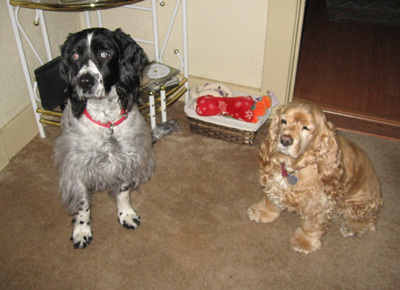 It's been nearly four years since the passing of Sage, my blind Springer Spaniel, and it's been less than two months since Cody, my cocker spaniel, died. I still miss both dogs. Each was a devoted friend, a faithful companion. Dogs are noted as faithful friends to humankind, often being called "man's best friend." Many news stories recount the dedication dogs have for their people, even for strangers. Those who alert humans to seizures, fire and other dangers; those who protect people from intruders; those who travel great distances to be reunited with their human family, and those that save people from drowning and avalanches – we learn about such stories nearly every day. Cats and dogs are used as therapy, serving in hospitals, nursing homes, and counseling centers. Loyalty is inherent in the gift of a four-footed friend.
It's been nearly four years since the passing of Sage, my blind Springer Spaniel, and it's been less than two months since Cody, my cocker spaniel, died. I still miss both dogs. Each was a devoted friend, a faithful companion. Dogs are noted as faithful friends to humankind, often being called "man's best friend." Many news stories recount the dedication dogs have for their people, even for strangers. Those who alert humans to seizures, fire and other dangers; those who protect people from intruders; those who travel great distances to be reunited with their human family, and those that save people from drowning and avalanches – we learn about such stories nearly every day. Cats and dogs are used as therapy, serving in hospitals, nursing homes, and counseling centers. Loyalty is inherent in the gift of a four-footed friend.
People could, and should, take lessons from pets in the subject of loyalty. Adultery, lack of romantic commitment, fizzling of friendship, embezzlement, bullying -- all of these negative character traits, among so many others, speak to the nasty side of humankind; these attitudes and actions are not displayed in our furry companions.
What bonds a pet to a person? People are the caregivers of their pets, feeding, exercising, playing, petting, lounging; we are the guardians. The more one positively interacts with their pet, the stronger the bond, just as the longer one befriends a person the deeper the dedication to that friendship. And yet, we humans can turn on each other in the blink of an eye.
When Sage and Cody were alive, if I was gone on a business trip for several days, my dogs would follow me everywhere upon my return. Our dog Mary waits in a chair that's beside the front door, and the minute my husband or I walk in, being gone for part of the day to work, she greets us with a little happy dance ... and one of her favorite toys. Our pets' desire to be with us speaks volumes about their bond to us.
We can learn a lot from our pets, including a great lesson in loyalty. Broken relationships, greed, selfishness and other negative characteristics often found in humans are rarely seen in pets. There’s a saying that goes, “May I become the person my dogs thinks I am.” That plaque hangs on my wall and it's a great reminder to aspire to be exactly that -- the person my pets think I am, the good person they see in and bring out in me.
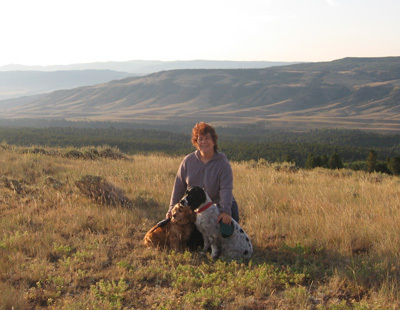
 It's been nearly four years since the passing of Sage, my blind Springer Spaniel, and it's been less than two months since Cody, my cocker spaniel, died. I still miss both dogs. Each was a devoted friend, a faithful companion. Dogs are noted as faithful friends to humankind, often being called "man's best friend." Many news stories recount the dedication dogs have for their people, even for strangers. Those who alert humans to seizures, fire and other dangers; those who protect people from intruders; those who travel great distances to be reunited with their human family, and those that save people from drowning and avalanches – we learn about such stories nearly every day. Cats and dogs are used as therapy, serving in hospitals, nursing homes, and counseling centers. Loyalty is inherent in the gift of a four-footed friend.
It's been nearly four years since the passing of Sage, my blind Springer Spaniel, and it's been less than two months since Cody, my cocker spaniel, died. I still miss both dogs. Each was a devoted friend, a faithful companion. Dogs are noted as faithful friends to humankind, often being called "man's best friend." Many news stories recount the dedication dogs have for their people, even for strangers. Those who alert humans to seizures, fire and other dangers; those who protect people from intruders; those who travel great distances to be reunited with their human family, and those that save people from drowning and avalanches – we learn about such stories nearly every day. Cats and dogs are used as therapy, serving in hospitals, nursing homes, and counseling centers. Loyalty is inherent in the gift of a four-footed friend.People could, and should, take lessons from pets in the subject of loyalty. Adultery, lack of romantic commitment, fizzling of friendship, embezzlement, bullying -- all of these negative character traits, among so many others, speak to the nasty side of humankind; these attitudes and actions are not displayed in our furry companions.
What bonds a pet to a person? People are the caregivers of their pets, feeding, exercising, playing, petting, lounging; we are the guardians. The more one positively interacts with their pet, the stronger the bond, just as the longer one befriends a person the deeper the dedication to that friendship. And yet, we humans can turn on each other in the blink of an eye.
When Sage and Cody were alive, if I was gone on a business trip for several days, my dogs would follow me everywhere upon my return. Our dog Mary waits in a chair that's beside the front door, and the minute my husband or I walk in, being gone for part of the day to work, she greets us with a little happy dance ... and one of her favorite toys. Our pets' desire to be with us speaks volumes about their bond to us.
We can learn a lot from our pets, including a great lesson in loyalty. Broken relationships, greed, selfishness and other negative characteristics often found in humans are rarely seen in pets. There’s a saying that goes, “May I become the person my dogs thinks I am.” That plaque hangs on my wall and it's a great reminder to aspire to be exactly that -- the person my pets think I am, the good person they see in and bring out in me.

Published on March 09, 2016 21:40
February 24, 2016
Pets Make Great Therapists
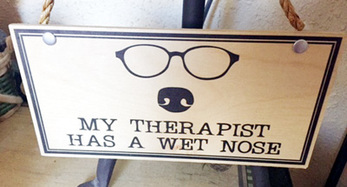 A sign hangs on my wall: “My Therapist Has a Wet Nose.” I bought the sign at a pet supply store a few years ago, and the saying is certainly true – in my house and in many other homes. My animals make great therapists – many pets do.
A sign hangs on my wall: “My Therapist Has a Wet Nose.” I bought the sign at a pet supply store a few years ago, and the saying is certainly true – in my house and in many other homes. My animals make great therapists – many pets do.Research shows pets provide great health benefits to people. They can reduce stress, lower blood pressure, and add years to our life. Experts tell us that pets help people who suffer from depression. The simple fact that our pets accept us for who we are, they love us unconditionally and are devoted companion, often waiting by the door for our return, makes us smile and builds our confidence and self-esteem. Dogs get us outdoors for fresh air and walks, and cats curl up in our laps and purr. All of these things and more are healthy benefits to people, both emotionally and physically.
People in nursing homes, hospitals, and hospice often feel weak, are in pain, and get discouraged. Many are lonely. Therapy pets raise their spirits, bringing smiles and joy into situations that can be sad and scary. Pet Partners , formally the Delta Society, and other groups certify pets and their owners for visiting these and other public places and studies show these animals provide great benefits to those whom they visit.
Although many people think of dogs when they envision pet therapy, dogs are not the only animals used for such work. Other animals, too, can be and are used in therapy situations; cats, bunnies, guinea pigs, even horses offer therapeutic value in various circumstances.
Unlike people with whom relationships can be complex, unpredictable, and stressful, animals are a great source of stability and companionship. Having a pet in one’s home can be calming and offer comfort when one is ill. Animals don’t change, and their loyalty to their owners and their ability to rebound from tough situations can be inspiring. The simple act of petting a dog or cat can lower blood pressure and bring a sense of calm to one’s spirit. Interacting with that pet in a playful manner can generate enjoyment and laughter. Even watching fish in a beautiful tank can bring about a sense of peace and an enjoyment of splendor through the colors of both the fish and the tank. And, don’t we all need a bit more tranquility, stability, and ability in our lives?
Pets are also a great source of comfort, especially for those affected by natural and other disasters. The K-9 Comfort Dogs from Lutheran Church Charities travel America to help quell the squall people experience after tornadoes, bombings, and other tragedies. Hugging a dog and allowing it to lick away tears of grief, fear, and anxiety brings comfort, and that's the job of the Lutheran Church Charities K-9 Comfort Dogs – and many other such animal-human programs.
No matter what we’re experiencing, we find love, devotion, acceptance and comfort from the furry friends around us … and we can share that special beauty with others by being partners with our pets in helping those in our community and our country through therapy and comfort animal programs.
Have you hugged your pet today? Do so, and put some special pet therapy in your day!
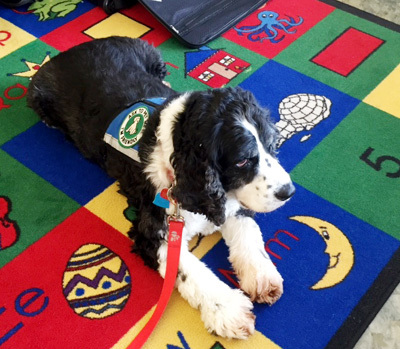
Published on February 24, 2016 07:51
February 11, 2016
The Love and Loyalty of Pets
 This is the month of love. Red hearts, chocolate candies, and colorful roses adorn the aisles of stores. Valentine's Day is close at hand, and yet many people don't have sweethearts,” at least not the human kind. But, you don't need a two-legged companion to know the joy of love and loyalty.
This is the month of love. Red hearts, chocolate candies, and colorful roses adorn the aisles of stores. Valentine's Day is close at hand, and yet many people don't have sweethearts,” at least not the human kind. But, you don't need a two-legged companion to know the joy of love and loyalty.Pets give us not just special companionship, but also devoted love. They are a constant reminder of what love and loyalty really are – the great comfort they bring when one has a stressful or difficult day, the joy they bring because they are always happy to see you, the solace they offer when you're ill, and the special companionship they give just simply by “being there.” Pets are truly amazing creatures!
I have been a pet owner since childhood. Both cats and dogs have graced my life and my home. As a child growing up on an Iowa farm, I spent endless hours outdoors, taking care of the animals and walking the woods surrounding our place. Most times, either a dog or cat accompanied me. Those memories transcend time and impact my life today.
I have an office space at home, an area I use for my writing projects. I've rarely been alone in that room. Furry friends kept, and continuing to keep, me company. Sage, Cody, and Mary snoozing on a dog bed a short distance from my desk, and cats Murphy and Bailey either lying right next to the computer or on a cat bed on top of the printer. My pets show deep devotion – they want to be where I am. Their loyalty and dedication rivals most human friendships, and their presence brings calm to my often chaotic life, especially when I face deadlines. Although Sage and Cody are no longer with us in body, I still feel them in spirit. And, when I look at their photos, memories abound. Sharing life's journey with pets is a priceless jewel – just like a diamond.
This Valentine's Day, whether you have a two-legged sweetheart or not, if you have a four-footed companion, then you have lots of love and loyalty in your life! Happy Valentine's Day!
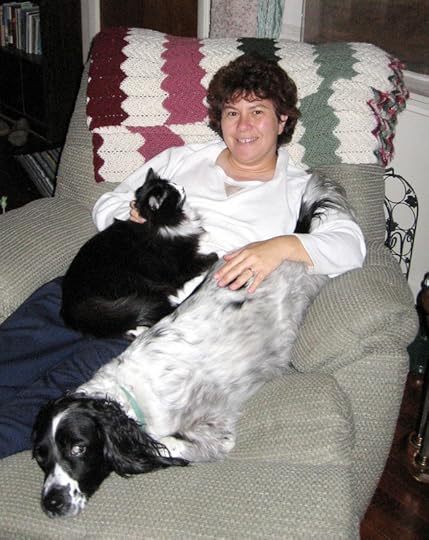
Published on February 11, 2016 21:26
January 24, 2016
A Tribute to Pets
 My husband and I lost our beloved cocker spaniel, Cody, this week. He was nearly 18 years old and had lived with us for nearly eight years. Our hearts are broken, even though we knew this day would come. Despite our sorrow, we are thankful for the many years, more years than expected when we adopted him for our local Humane Society animal shelter; he was almost ten years old at the time.
My husband and I lost our beloved cocker spaniel, Cody, this week. He was nearly 18 years old and had lived with us for nearly eight years. Our hearts are broken, even though we knew this day would come. Despite our sorrow, we are thankful for the many years, more years than expected when we adopted him for our local Humane Society animal shelter; he was almost ten years old at the time.In my blog post today at Writing Wranglers & Warriors, a blogging site primarily made up of writers of differing genres and interests, I write a Tribute to Pets, including Cody and Sage, the blind springer spaniel my husband and I were blessed to have for more than ten years. Both Cody and Sage are characters in my inspirational dogs books and stories, and both have positively impacted people's lives, including my own. I hope you'll stop over at the Writing Wranglers site and perhaps remember the pets who have touched your heart and positively impacted your life.
Here's the link: https://writingwranglersandwarriors.wordpress.com/2016/01/24/a-tribute-to-pets/
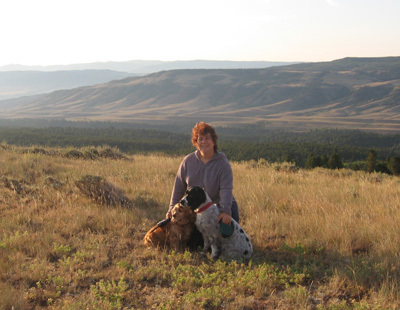
Published on January 24, 2016 06:41
January 9, 2016
Caring for Aging Pets
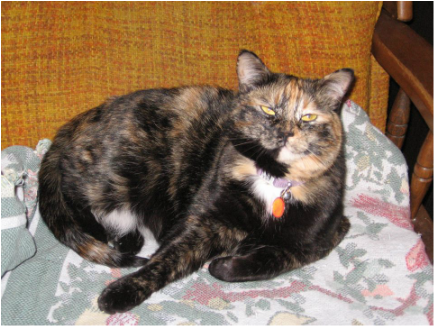 It's a new year, and with that fact comes another: we'll all turn another year older; so will our pets. Like humans, animals age. Whereas people can live to be 90 or older, sadly, our pets aren't with us that long – at least, not in years as we humans know them. According to the American Veterinary Medical Association (AVMA), cats and small dogs are considered “geriatric” at age seven, larger dog breeds even sooner. Generally, pets are considered in their “senior years” around age 10 (younger for large dog breeds).
It's a new year, and with that fact comes another: we'll all turn another year older; so will our pets. Like humans, animals age. Whereas people can live to be 90 or older, sadly, our pets aren't with us that long – at least, not in years as we humans know them. According to the American Veterinary Medical Association (AVMA), cats and small dogs are considered “geriatric” at age seven, larger dog breeds even sooner. Generally, pets are considered in their “senior years” around age 10 (younger for large dog breeds).The adage “one dog year is equivalent to seven in human years” may make things simple for people in terms of age calculation; however, according to the AVMA, it's not as easy as that. Although a small seven-year-old dog or a cat may be about 45 years old in human years, a seven-year-old large dog is closer to a 50 to 55-year-old person. A 15-year-old cat or small dog is considered about 75 years of age in human years and a large 10-year-old dog is about that same age in human terms. Learn more about animal age at https://www.avma.org/public/PetCare/Pages/Caring-for-an-Older-Pet-FAQs.aspx .
With increased years comes increased, and differing, health issues, from mobility concerns to cancer. How do we care for our aging pets? Here are a few tips:Feed your furry friend nutritious food. Aging brings health concerns, such as diabetes, weight, and kidney/urinary tract disease. A more nutritious food can help senior pets, and some many need specialty food. Talk with your veterinarian about the type of diet your older pet may need. S/he can make recommendations about quality pet food brands or special formulas your senior friend needs to thrive in its older age. Keep your pet at a healthy weight. Again, quality food will help as will continued regular exercise, although the type of exercise your pet engages in might need to be changed (instead of running and hiking, your older dog may need to scale back to walking short distances).Schedule regular check-ups with your veterinarian. You may need to increase your visits from once a year to twice a year – a lot can change in a senior pet's life between veterinary visits, and keeping tabs on your pet's health, including any changes, is the key to maintaining good health or changing diet/medications/etc.Ensure good teeth in your pet. Dental care is critical to your four-footed companion's health. Brush your pet's teeth and consult with your vet about regular cleanings. Tartar build-up can cause gingivitis, which can cause bacteria to get into your dog or cat's bloodstream, causing major problems to its vital organs. Is your pet incontinent? This can be a sign of simple aging or of a more complex medical issue. Consult your veterinarian if this situation arises. Using pee pads and doggie diapers may be two ways to deal with incontinence. Limiting your pet's water intake, especially at night, may also help.
For more information on senior pet care, visit these websites:
http://www.petmd.com/dog/care/evr_dg_caring_for_older_dogs_with_health_problems
https://www.petfinder.com/dogs/dog-care/senior-dog-care/
and
http://www.vetstreet.com/dogs/caring-for-senior-dogs-what-you-need-to-know
My pets are nine and older. One is experiencing major health issues, our cocker spaniel Cody, who is nearly 18. Arthritis, incontinence, deafness, and cataracts are among his health problems. I've had only one pet live to this age – she didn't have the number of medical conditions that Cody has, so this is a new journey for me. However, I'm thankful for each day I share with Cody, snuggling on the couch or taking (very) short walks in the yard or at our mountain property. Sometimes it's a struggle to deal with my elderly guy's medical problems (from “doggie dementia” and bad teeth to loss of senses and bladder control). But, dealing with kids and aging parents is also challenging, therefore, the understanding and patience required are all the more sweet and necessary for this journey … and for life's journey.
Our time with our elderly furry family members, as well with as our human family members, is precious. Take the best care possible with your pet and enjoy the journey for as long it lasts. Our animals' loyalty and affection deserve returning.
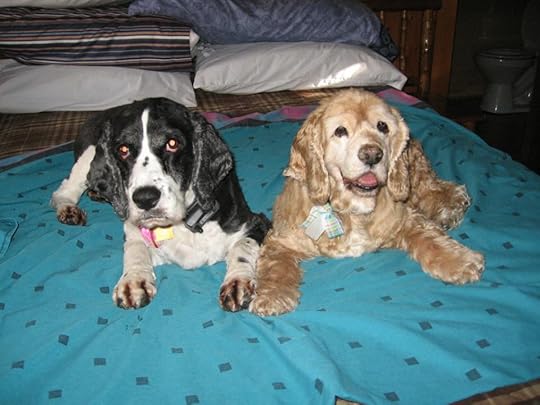
Published on January 09, 2016 08:42
December 31, 2015
Winter Safety Tips for Pet Owners
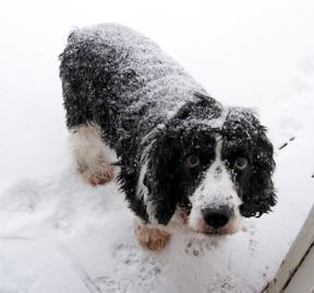 The chilling grip of winter is upon us in many areas, and with this season comes potentially harmful issues for our pets, from frostbite to poisoning. Below are some ideas to keep your pet warmer and safer during the next few months of the New Year:
The chilling grip of winter is upon us in many areas, and with this season comes potentially harmful issues for our pets, from frostbite to poisoning. Below are some ideas to keep your pet warmer and safer during the next few months of the New Year:Short-haired dog breeds or older animals may need a coat to wear outside while on a walk. No one likes feeling like an icicle, including our beloved pets, so if you have a dog that's affected by colder temperatures, provide an extra layer of warmth in the form of a coat. Also, it's not a good idea to shave your pet to the skin during the winter months – the animal's fur helps insulate it from the harsh winter weather. Therefore, make sure your groomer doesn't give your furry friend too much of a hair cut this season.
The pads of a pet's feet can become frost-bitten if they are outdoors for too long. Ice, snow and other materials can also be painful if picked up while outside. Many mushers and other dog owners use booties specifically made for dogs; you, too, may find those beneficial for your pet.
Don't let your dog off-leash while outdoors, especially during a snowstorm. Dogs often rely on scent to find their way, and they can lose this sense easily in snow and wind. According to the ASPCA (American Society for the Prevention of Cruelty to Animals), more dogs are lost during winter months than during other times of the year.
Therefore, make sure your pets have ID tags and/or microchips so they can be returned home if they do become lost.Create a warm place for your pet to sleep, if they sleep inside the house or in a kennel in the backyard. If you have outdoor animals, provide them with a strong, cozy shelter, including straw for warmth inside the barn or doghouse. If your pets live indoors, a snug bed keeps them warmer and is more comfortable than the hard, cold floor.When your dog is bathed, make sure he is completely dry before going outdoors.After returning from a walk, clean your dog’s paws, legs and stomach area when you return home. He can ingest anti-freeze, salt, and other harmful chemicals if allowed to clean himself.Remember that anti-freeze poisons pets, so keep your animals away from it.
Keep your cat indoors during the winter. Felines can freeze, become lost, or contract a deadly disease such as rabies. Additionally, many people feed wild birds during the winter, and cats can be deadly on these lovely wild things that others are not only caring for, but also enjoy watching at the feeders.
Cats also may climb into the engines of vehicles, so if there are outdoor cats in your area, prior to starting your car's engine, bang on the hood to scare away any potential stowaways. Fan belts seriously injure, even kill, cats and other small animals that crawl into a car's engine. So, double-check before starting your vehicle's engine.
Putting these guidelines into action will help keep your four-footed companion warmer and safer during these winter months of cold, ice and snow.
Published on December 31, 2015 13:41
December 20, 2015
Prevent Pet Stress During the Holidays
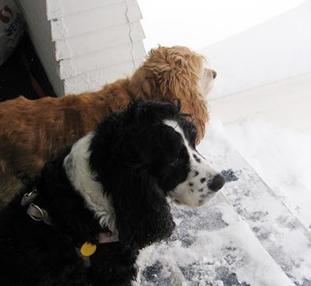 We are in the last week before Christmas, a time can that be hectic for humans. Our busy schedules, last minute parties and holiday preparations, including Christmas shopping, often translates into irritability and stress. Be mindful that the furry friends which share our homes can take on the stress we often feel.
We are in the last week before Christmas, a time can that be hectic for humans. Our busy schedules, last minute parties and holiday preparations, including Christmas shopping, often translates into irritability and stress. Be mindful that the furry friends which share our homes can take on the stress we often feel.From frenzied moods to throwing together food, from gathered guests to giving gifts, we take on extra duties and extra stress during this special season of the year. Our pets take on the tension that radiates from us—they, too, can experience anxiety which can lead to health problems (giving you something else to stress about!)
Just like with us, pets stress for a variety of reasons; we have ways and opportunities to lessen our pets' stress. For example, provide a quiet space for your furry friend to escape the holiday hoopla. As you entertain with parties and dinners, keep in mind that your pets can become nervous with so many people and so much noise. We know why all these people are milling around our house, but our pets do not. To help your furry friend deal with the extra people and commotion, set aside a special room far enough away from the noise so your pet can relax. But, don’t desert him/her – visit your dog/cat in that quiet room so it doesn’t stress from feeling abandoned.
If, however, your pet enjoys the attention given by your guests, let it hang out with you awhile. But, first make sure your guests know you have a pet in the home (some people are allergic to animal dander and others don’t welcome fur on their clothing). Make sure your pets and guests will mix well by first reminding people that there are pets in your home.
Once that formality is understood and accepted, don’t let your guests feed table scraps to Fido or Fluffy. Human food can throw off your pet’s nutritional balance, and some foods, like chocolate, can be harmful to your dog's and cat's health. Setting down your furry one's supper while you and your guests sit down to dinner helps curb the temptation to indulge your pets with table scraps.
Guests that are fearful of animals can also be a source of stress for you, your guest, and your furry companions. Perhaps your guest is not actually fearful but unaccustomed to being around animals. Prepare your company ahead of time, telling them, for example, what type of dog you have and what its personality is like. If your dog has a loud bark, be sure to let your guests know to expect that when they knock on your door. If your cat likes to sit on people’s laps, warn your guests ahead of time – or confine Fluffy to a room away from your dinner guests. But, as mentioned, don’t forget her! Either yourself or your children should spend time with a pet that’s kept away from everyone during a holiday party or Christmas dinner.
Another source of pet stress during the holidays is travel. Maybe you and your family are driving to Grandma’s and planning to take Fido with you (Grandma has said it’s okay to bring your furry friend with you). Some animals get car sick. Vets estimate that one in six dogs experience motion sickness. Therefore, as a precaution, talk with your vet prior to traveling (especially a long distance) – s/he can provide a relaxant medication to help pets travel with less stress and less sickness. Warning signs that your pet is experiencing motion sickness include increased drooling, excessive swallowing, and too much panting.
If you are planning to be away from home during the upcoming Christmas and New Year's week and are not taking your furry companions with you, make sure you don't leave them alone. Arrange ahead of time for an in-home pet sitter (helpful websites to find such caregivers include https://www.rover.com/, https://dogvacay.com/, and https://www.care.com) or to board your pet at a kennel or with your veterinarian. NEVER leave your pet home alone while you're on vacation; even asking friends to "stop by and check/feed" is not the best idea, especially during the holiday season. Pets can be forgotten even by the most well-intentioned friend, or an emergency can call that person out of town. Pets left alone for extended periods of time can become destructive -- the last you want/need is to return home from Grandma's or Uncle Joe's in another state and find your furniture destroyed and your pet injured or worse. Talk about stress on you and your four-footed friend!
The holidays are meant to be enjoyed. We often experience stress and anxiety during this time of year; our pets can experience those feelings as well. So, do your best to reduce both your stress level and that of your furry friend this holiday season. Rest, take some down time, and enjoy your loved ones, including your furry companions – and ensure your pets have those same opportunities.
MERRY CHRISTMAS and HAPPY NEW YEAR!

Published on December 20, 2015 18:01
December 11, 2015
Christmas Joy, Not Chaos!
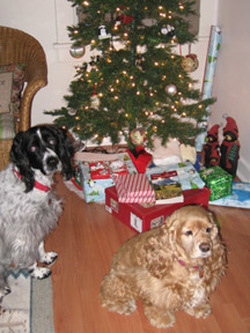 The Christmas season is upon us and with its hoped-for joy can also come chaos. As people hurry and scurry, pets tend to be neglected and their safety often overlooked. However, as you prepare for this special holiday, don’t let your hustle and bustle bring disaster to your pets. Here are some tips to help keep your furry companions safe during this busy time of year:
The Christmas season is upon us and with its hoped-for joy can also come chaos. As people hurry and scurry, pets tend to be neglected and their safety often overlooked. However, as you prepare for this special holiday, don’t let your hustle and bustle bring disaster to your pets. Here are some tips to help keep your furry companions safe during this busy time of year:Christmas trees and decorations are lovely to look at, but they can cause issues for our pets. Garland and tinsel, for example, may be ingested, choking or even killing your pet. Candles can be knocked over by either people or pets and cause a fire. Therefore, when using decorations, choose those that pose less danger to your pets and your household in general.Christmas trees may be knocked over by cats climbing into them or by pets attracted to the decorations hanging on them. If you use fragile tree decorations, keep those in the higher branches away from curious pets. You might also consider securing your tree to a wall to prevent it from "fainting" due to animal activity!
Make sure your pet always has fresh water in its dish so it’s not tempted to drink from the water at the base of your live Christmas tree. Place a tree skirt around the tree to cover the water in the base. Christmas tree water becomes dirty and stagnant, and pets that drink it can ingest not only the bacteria, but also pine needles that drop, all causing potential harm to your pet.Make sure all electrical outlets and connections are secured and concealed. This protects not only your pets, but also any small children who may visit or live in your home.Some plants that people enjoy at Christmas pose health hazards for pets, including mistletoe and poinsettia. Keep these out of your pets’ reach or consider purchasing artificial ones.... or a safer variety of live plant.
As people come and go from your home, your dog or cat can more easily escape due to doors opening and closing. You may want to put your pet in an extra bedroom or the laundry room if you expect people to be in and out a lot on a particular day, such as for a holiday party or your family’s Christmas Day celebration.
Make sure your pets have collar and ID tags in case they do rush out the door. Pets can become lost fairly easily, and with winter’s cold and snowy days, you want your beloved animal returned home as quickly as possible – ID tags are vital to that goal. Consider investing the small amount of money it takes for your vet to implant a microchip. Collar and tags can become lost themselves, and a microchip can help get your pet home if the collar and tags are missing from its neck. Remember to keep that identification up-to-date.
Food is an integral part of the Christmas season, and there are many items that are health hazards for our pets, such as poultry bones, gravy and chocolate. Keep your pets’ food routine the same during the holiday season as during ‘regular days’ – you’ll avoid upset stomachs or worse.
9. The excitement, busyness and stress we experience during the holidays can also stress our pets.
Create a quiet place for your dog or cat to go in order to get away from the commotion. Set up a
room in the house away from the noise with things that your pet is comfortable: its bed or special
blanket, toys, and food and water dishes.
Follow these simple tips, and you, your family and your pet will more greatly enjoy the Christmas season!
Published on December 11, 2015 08:03
November 29, 2015
Share the Love This Holiday Season
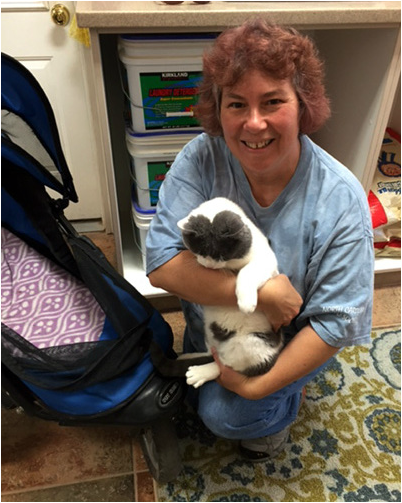 Thanksgiving has passed and we are officially into the Christmas season, a time of sharing, joy, and love. An 1800’s Christmas carol states, “Love came down at Christmas…” Subaru features an annual “share the love” event. We can take these thoughts of love and sharing and apply the principles all around us, including to pets. Whether our own, an animal belonging to a family member or friend, or even (and especially) the homeless creatures in our community and beyond – each and every pet needs the love, joy, and security of human companionship.
Thanksgiving has passed and we are officially into the Christmas season, a time of sharing, joy, and love. An 1800’s Christmas carol states, “Love came down at Christmas…” Subaru features an annual “share the love” event. We can take these thoughts of love and sharing and apply the principles all around us, including to pets. Whether our own, an animal belonging to a family member or friend, or even (and especially) the homeless creatures in our community and beyond – each and every pet needs the love, joy, and security of human companionship.Sadly, many pets don't experience those positive principles. Instead, they are cramped into tiny cages at the hands of puppy millers – backyard breeders who only want to make money from the litters of puppies and kittens derived from unspayed/unneutered animals. Similar to assembly production lines, these dogs and cats are bred time and again for years on end, and are often unsocialized and in great need of medical care. Organizations such as National Mill Dog Rescue (NMDR) in Colorado Springs, Colorado make their mission of saving dogs from such horrible conditions and providing them the love and care they need, desire, and deserve. Recently, NMDR sent out volunteers to rescue dogs confined in deplorable conditions in several Midwestern states – the compassionate volunteers returned to Colorado with more than 60 dogs of varying breeds, including Shih Tzu, Yorkshire terrier, and German shepherd. Some lacked teeth and most were matted to the hilt. Several were very shy from lack of loving human contact while others responded with great joy and dancing after being rescued, bathed, and loved.
The meaning of Christmas is love and sharing. We can all step up to the plate in this regard, showering our human and animal neighbors with the love and compassion each living creature needs. Lives are changed by acts of love and compassion, and the lives of pet rescue and shelter workers and volunteers are positively impacted by care shown to them by community members.
My husband and I recently visited Best Friends Animal Sanctuary in Kanab, Utah. Open for more than 30 years, this amazing organization takes in dogs, cats, rabbits, horses, parrots, and other animals in need of rest, rehabilitation, and re-homing. They serve more than 1,800 different animals each year. Best Friends staff and volunteers conducted a massive rescue during Hurricane Katrina, and the organization was instrumental in saving the dogs Michael Vick and his cadre used for fighting. I volunteered at Cat World, taking kitties on leashed-walks and baby/cat buggy strolls. I played with and petted the cats – several simply wanted a lap to curl up in and receive loving strokes along the back and behind the ears. Petting an animal not only comforts them, but also helps relieve stress in people. As I sat with these cats, either in shade or under a canopy of blue sky and autumn sunlight, relaxation ensured for me and them. I can’t wait to return again to do more volunteer work!
A person doesn't have to travel hundreds of miles to make a difference in the lives of animals – we can help those at our local rescues and shelters, in our own homes, and the homes and neighborhoods of our friends and families. Let’s take this holiday season to do something to make a positive impact, a “share the love event,” bestowing compassion, kindness, joy, and care upon our fellow living beings. Share your gifts of time, talent, and treasure. Donations of food, supplies, and funds go a long way to help the rescues and shelters. Gifts of volunteerism speak volumes to organizations reaching out to the hurting and homeless and to those whom they serve. Walking the neighbor’s or grandparents dog, playing with a friend’s cat, or spending extra time with your own pets also rains blessings upon animals and people.
How can you share the love with pets and people this season? The ways are endless! My hope is we come together as a community to end animal cruelty, including mills, and unite to help homeless pets until there are no more unwanted, unloved furry companions.
Published on November 29, 2015 12:51



